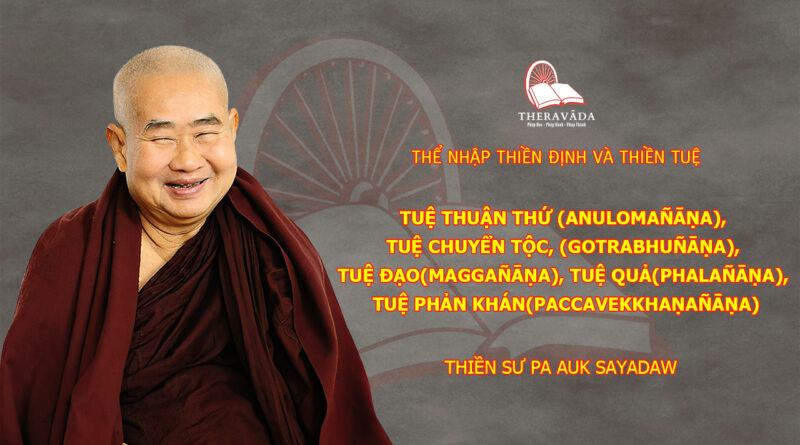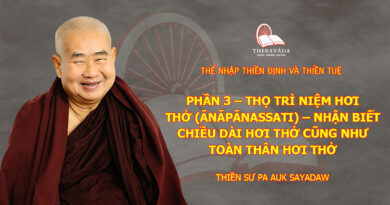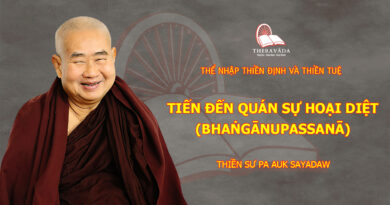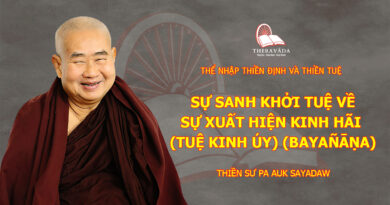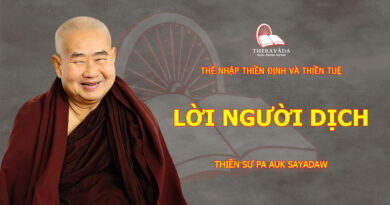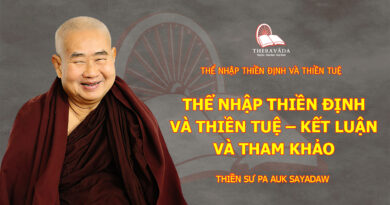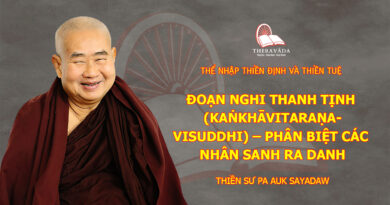Conformity Knowledge (Anuloma-ñāṇa), Change-of- Lineage Knowledge (Gotrabhuñāṇa), Path Wisdom (Maggañāṇa), Fruition Wisdom (Phalañāṇa), Reviewing Wisdom (Paccavekkhaṇañāṇa)
|
Tuệ Thuận Thứ (Anulomañāṇa), Tuệ Chuyển Tộc, (Gotrabhuñāṇa), Tuệ Đạo(Maggañāṇa), Tuệ Quả(Phalañāṇa), Tuệ Phản Khán(Paccavekkhaṇañāṇa)
|
| As he repeats, develops and cultivates that equanimity towards-formations, his faith becomes more resolute, his energy better exerted, his mindfulness better established, his mind better concentrated, while his equanimity about formations grows more refined. Then when his meditating wisdom emerges from the dissolution of formations called ‘pavatta’ and sees the unformed and undissolved nature of Nibbana called ‘apavatta’, the following cognitive series of consciousness arises. |
Khi hành giả lặp lại, tu tập và trau dồi sự quân bình với các hành, tín tâm của hành giả sẽ thêm kiên định, tinh tấn được sử dụng tốt hơn, niệm được an trú tốt hơn, tâm định tốt hơn, trong khi sự quân bình với các hành được tăng trưởng tinh tế hơn. Sau đó, khi trí tuệ thiền của hành giả thoát ly khỏi sự diệt của các hành được gọi là “pavatta” và thấy bản chất vô vi và không bị hoại diệt của Niết-bàn (Nibbāna) được gọi là “apavatta”, lộ trình tâm sau đây sanh khởi. |
| (Mandapaññā) – “Na-Da-Ma-Pa-U-Nu-Go-Magga-Phala-Phala” -Bh- |
(Mandapaññā) – “Na-Da-Ma-Pa-U-Nu-Go-Magga-Phala-Phala” -Bh- |
| (Tikkhapaññā) – “Na-Da-Ma-U-Nu-Go-Magga-Phala-Phala-Phala” -Bh- |
(Tikkhapaññā) – “Na-Da-Ma-U-Nu-Go-Magga-Phala-Phala-Phala” -Bh- |
| Na = bhavaṅga-calana – vibrating life-continuum |
Na = bhavaṅga-calana – hữu phần (hộ kiếp) rúng động |
| Da = bhavaṅgu-paccheda – arrested life-continuum |
Da = bhavaṅgu-paccheda – hữu phần (hộ kiếp) dứt dòng |
| Ma = manodvārāvajjana – mind-door adverting consciousness |
Ma = manodvārāvajjana – ý môn hướng tâm |
| Pa = Parikamma – preparation of the Path (magga) |
Pa = parikamma – chuẩn bị của Đạo (magga) |
| U = upacāra – proximity of the Path (magga) |
U = upacāra – cận hành của Đạo (magga) |
| Nu = anuloma – conformity to what preceeds and to what follows |
Nu = anuloma – thuận thứ cho cái đi trước và cái theo sau |
| Go = gotrabhu – change-of-lineage |
Go = gotrabhu – chuyển tộc |
| Magga = sotāpattimagga – the Path of stream-entry |
Magga = sotāpattimagga – Đạo Nhập Lưu |
| Phala = sotāpatti-phala – the Fruition of stream-entry |
Phala = sotāpatti-phala – Quả Nhập Lưu |
| Bh = bhavaṅga – life-continuum |
Bh = bhavaṅga – hữu phần (hộ kiếp) |
| When the object of formations as impermanence or pain or not-self appears at the mind-door, life-continuum vibrates twice (Na-Da) and is arrested or cut off. After that manodvārāvajjana (Ma) adverts the mental stream towards the object, apprehends it and decides whether it is anicca, dukkha or anatta.. Then one of the four sense-sphere wholesome consciousness associated with knowledge (ñāṇasampayutta mahākusala citta) arises four times, functioning as preparation (Pa), proximity (U), conformity (Nu), and change-of-lineage (Go). |
Khi đối tượng của các hành là vô thường, hoặc khổ, hoặc vô ngã xuất hiện ở ý môn, tâm hữu phần (hộ kiếp) rúng động hai lần (Na-Da) và bị ngừng lại hay cắt đứt. Sau đó, ý môn hướng tâm (manodvārāvajjana) (Ma) hướng dòng tâm đến đối tượng, thẩm sát nó và quyết định xem nó là vô thường (anicca), khổ (dukkha) hay vô ngã (anatta). Sau đó, một trong bốn tâm đại thiện dục giới tương ưng trí(ñāṇasampayutta mahākusala citta) sanh khởi bốn lần, phận sự là chuẩn bị (Pa), cận hành(U), thuận thứ (Nu), và chuyển tộc (Go). |
| ‘Preparation’ does the preliminary work of preparation for the arising of the Path. |
“Chuẩn bị” làm nhiệm vụ mở đầu cho việc chuẩn bị phát sanh Đạo. |
| ‘Proximity’ functions as access to the Path. |
“Cận hành” có phận sự là tiếp cận Đạo. |
| ‘Conformity’ conforms to the functions of truth both in the eight preceeding kinds of insight knowledge and in the thirty-seven requisite factors of enlightenment (Bodhipakkhiya) that follow. |
“Thuận thứ” làm thích ứng các phận sự thấy chân lý cả ở trong tám loại tuệ minh sát đi trước và ở trong ba mươi bảy yếu tố giác ngộ(Bodhipakkhiya) theo sau. |
| The knowledge associated with these three cittas (parikamma, upacāra, anuloma) is the highest insight knowledge known as the “knowledge of conformity” (anuloma-ñāṇa). |
Tuệ kết hợp với ba tâm này (chuẩn bị – parikamma, cận hành – upacāra, thuận thứ – anuloma) là tuệ minh sát cao nhất được biết là “tuệ thuận thứ” (anuloma-ñāṇa). |
| Gotrabhu does not take formations as its object; it takes Nibbāna as its object and points out Nibbāna so that the Path-consciousness (Magga citta) can arise after it, also taking Nibbāna as its object. It is like the sailor’s crow pointing’ out the land so that the ship can sail on towards the land. It is called change-of-lineage because it changes the lineage of the meditator from a worldling (puthujjana) to a noble person (ariya). Up to gotrabhu citta the yogi is still a worldling (one who is bound by all ten fetters). But as soon as Magga citta arises, the yogi becomes a noble person. |
Gotrabhu (chuyển tộc) không lấy các hành làm đối tượng; nó lấy Niết-bàn làm đối tượng của nó và chỉ ra Niết-bàn, do đó tâm Đạo(Magga citta) có thể sanh khởi lên sau nó, cũng lấy Niết-bàn làm đối tượng. Nó giống như con quạ của người thủy thủ chỉ ra đất liền để con thuyền có thể hướng đến đất liền. Nó được gọi là tuệ chuyển tộc vì nó thay đổi dòng dõi của hành giả từ phàm nhân(puthujjana) sang thánh nhân (ariya). Cho đến tâm chuyển tộc (gotrabhu citta), hành giả vẫn còn là một phàm nhân (là người bị trói chặt bởi mười kiết sử). Nhưng ngay khi tâm Đạo(Magga citta) sanh khởi, hành giả trở thành một thánh nhân. |
| Although the knowledge of conformity (anulomañāṇa) is the end of the insight leading to emergence that has formations as its object, still the “change-of-lineage knowledge” (gotrabhuñāṇa) is the last of all kinds of insight leading to emergence. |
Mặc dù tuệ thuận thứ (anulomañāṇa) là tuệ minh sát cuối cùng dẫn dắt đến sự giải thoát mà lấy các hành làm đối tượng, tuy nhiên, “tuệ chuyển tộc” (gotrabhuñāṇa) là tuệ cuối cùng trong tất cả các loại tuệ minh sát dẫn dắt đến sự giải thoát. |
| Magga citta always arises just once performing its fourfold function-viz., (1) comprehension of the truth of suffering, (2) eradication of craving which is the cause of suffering, (3) realization of Nibbāna, and (4) full development of the eight constituents of the Path. |
Tâm Đạo (Magga citta) luôn luôn chỉ sanh khởi chỉ một lần, thực hiện bốn chức năng, đó là, (1) thấu rõ chân lý về khổ, (2) nhổ tận gốc rễ tham ái là nguồn gốc của khổ, (3) chứng ngộ Niết-bàn, và (4) phát triển trọn vẹn Bát Thánh Đạo. |
| Soon after the Magga citta dissolves, its Fruition, i.e. Phala citta, arises twice without any lapse in time (akāliko) taking Nibbāna as its object. This cognitive series is for a yogi of sluggish wisdom (mandapaññā). For a yogi of swift wisdom (tikkhapaññā), parikamma is absent and Fruition consciousness (Phala citta) arises three times. As soon as Fruition citta arises, the yogi becomes a stream-enterer (sotāpanna).187 He can enjoy the unique bliss of Nibbāna as much as he likes and is fully guaranteed never to be reborn in woeful abodes. |
Ngay sau khi tâm Đạo (Magga citta) diệt, quả của nó, tức là tâm Quả (Phala citta), sanh khởi hai lần không ngắt quãng theo thời gian(akāliko), lấy Niết-bàn (Nibbāna) làm đối tượng. Lộ trình tâm này là cho hành giả có trí tuệ chậm lụt (mandapaññā). Đối với hành giả có trí tuệ bén nhạy (tikkhapaññā), thì tâm chuẩn bị (parikamma) vắng mặt và tâm Quả(Phala citta) sanh khởi ba lần. Ngay khi tâm Quả sanh khởi, hành giả trở thành một vị thánh Nhập Lưu (sotāpanna188). Hành giả có thể thọ hưởng sự an lạc vô song của Niết-bàn theo ý muốn và được đảm bảo hoàn toàn rằng không bao giờ tái sanh trong các cõi khổ. |
| The knowledges associated with the Path consiousness and the Fruition consciousness are known as the “Path wisdom” (Maggañāṇa) and the “Fruition wisdom” (Phalañāṇa) respectively. |
Tuệ kết hợp với tâm Đạo và tâm Quả được biết tương ứng là “tuệ Đạo” (Maggañāṇa) và “tuệ Quả” (Phalañāṇa). |
| After the magga-vīthi and a few bhavaṅga cittas have passed by, five paccavekkhaṇa-vīthis (reviewing cognitive series) normally arise. By these vīthis the yogi (1) reviews the Path, (2) reviews the Fruit, (3) reviews Nibbāna, (4) reviews the defilements (diṭṭhi and vīcikicchā) he has annihilated, and (5) reviews the defilements remaining to be annihilated. The knowledge associated with these javana cittas is called “reviewing wisdom” (paccavekkhaṇañāṇa).189 |
Sau lộ trình tâm đạo (magga-vīthi) và một vài tâm hữu phần (bhavaṅga citta) trôi qua, thông thường, năm lộ trình tâm phản khán(paccavekkhaṇa-vīthi) phát sanh. Qua những lộ trình tâm (vīthi) này, hành giả (1) suy xét Đạo, (2) suy xét Quả, (3) suy xét Niết-bàn, (4) suy xét các phiền não (diṭṭhi và vīcikicchā) đã được đoạn diệt, và (5) suy xét các phiền não chưa được đoạn diệt. Tuệ kết hợp với các tốc hành tâm (javana citta) này được gọi là “tuệ phản khán” (paccavekkhaṇañāṇa)190. |

